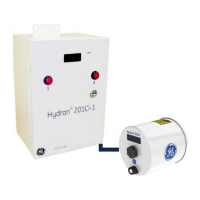MA-033 Rev. 14.0, 12-Nov-18
Hydran* 201i Instruction Manual
• If the sensor test fails (in other words, if an alarm condition is detected), the fail
alarm is triggered, the test result is recorded in the historic data file Events and a
message is displayed on the H201Ti’s display.
Note: All alarms are ignored for two minutes following the H201 sensor test.
The messages that can be displayed following a sensor test are shown in Table 5-6
below. For the troubleshooting procedure for each of these alarms, see Section 13.1).
In addition to the manual tests, a semimonthly, automatic test of the H201 sensor is
performed the first and fifteenth days of each month at midnight. For each automatic
test, certain parameters are recorded in the historic data file Service (see Section 5.5.1.4)
for further analysis by General Electric.
Note: Each H201Ti is configured for a specific H201 sensor. If you receive more than one
H201Ti’s, take the necessary precautions not to interchange the sensors and H201Ti’s.
Hydran 201 sensor operating properly
Damaged sensor, replace immediately
Cable disconnected, broken or misconnected
Cable misconnected or short-circuited
Unable to perform the test
Table 5-6: Messages that can be displayed following a Sensor Test
5.5.4.3 Battery
This function is used to read the battery voltage and set the battery’s alarm parameters:
• Battery: Voltage reading at the battery’s terminals.
• Batt.Alr LL: Set point of battery Low-Low alarm.
• Batt.Alr L: Set point of battery Low alarm.
• Batt.Alr Delay: Alarm delay for both set points.
A fail alarm is triggered if the voltage of the battery gets below the Low or Low-Low
alarm set point for a period of time longer than the delay.
Note: The Batt.Alr Delay parameter is reset each time the Setup Lost alarm condition is
detected. This parameter must be set to its former operation value after the alarm
condition has disappeared.
For explanations pertaining to the H201Ti’s battery, see Section 3.7.

